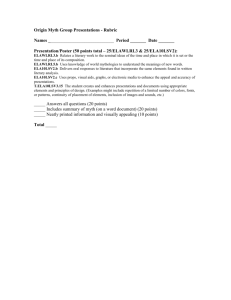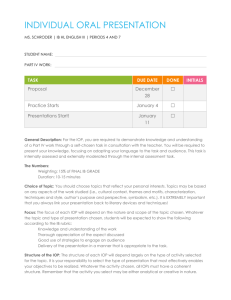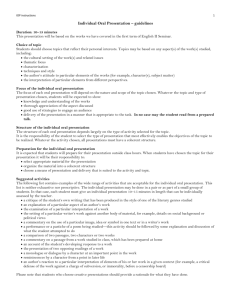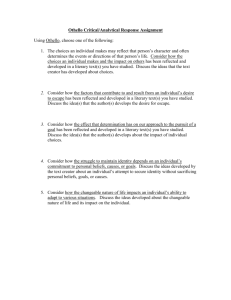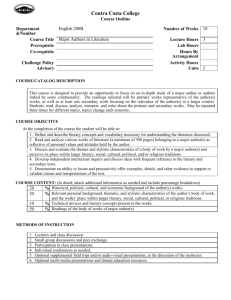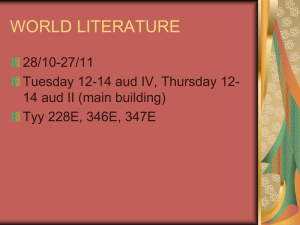Individual Oral Presentation
advertisement
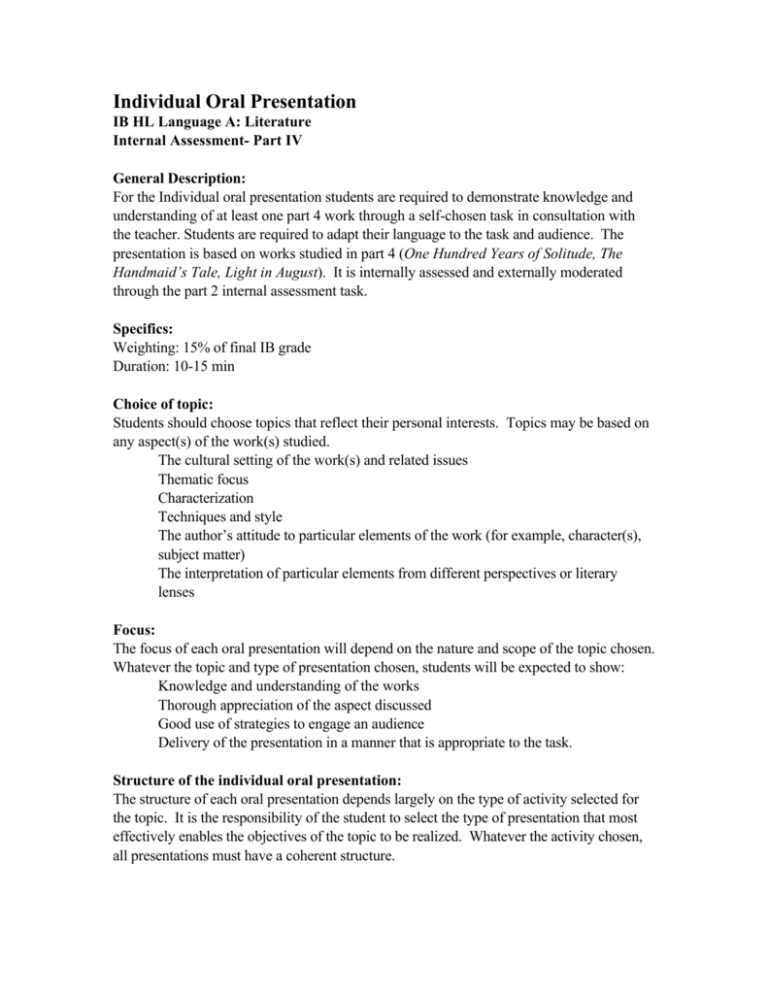
Individual Oral Presentation IB HL Language A: Literature Internal Assessment- Part IV General Description: For the Individual oral presentation students are required to demonstrate knowledge and understanding of at least one part 4 work through a self-chosen task in consultation with the teacher. Students are required to adapt their language to the task and audience. The presentation is based on works studied in part 4 (One Hundred Years of Solitude, The Handmaid’s Tale, Light in August). It is internally assessed and externally moderated through the part 2 internal assessment task. Specifics: Weighting: 15% of final IB grade Duration: 10-15 min Choice of topic: Students should choose topics that reflect their personal interests. Topics may be based on any aspect(s) of the work(s) studied. The cultural setting of the work(s) and related issues Thematic focus Characterization Techniques and style The author’s attitude to particular elements of the work (for example, character(s), subject matter) The interpretation of particular elements from different perspectives or literary lenses Focus: The focus of each oral presentation will depend on the nature and scope of the topic chosen. Whatever the topic and type of presentation chosen, students will be expected to show: Knowledge and understanding of the works Thorough appreciation of the aspect discussed Good use of strategies to engage an audience Delivery of the presentation in a manner that is appropriate to the task. Structure of the individual oral presentation: The structure of each oral presentation depends largely on the type of activity selected for the topic. It is the responsibility of the student to select the type of presentation that most effectively enables the objectives of the topic to be realized. Whatever the activity chosen, all presentations must have a coherent structure. Preparation for the individual oral presentation: It is expected that students will prepare for their presentation outside class hours. When students have chosen the topic for their presentation it will be their responsibility to: Select appropriate material for the presentation Organize the material into a coherent structure Choose a means of presentation and delivery that is suited to the activity and topic. Complete an IOP proposal form After your proposal is accepted by the teacher, complete an outline and works cited page for an analytical presentation OR a product and statement of intent for a creative presentation. Remember that you should provide an oral statement of intent at the beginning of a creative presentation (this will count in your time). Suggested Activities: The following list is an example of the wide range of activities that are acceptable for the individual oral presentation. This list is neither exhaustive nor prescriptive. Students should select the activity most appropriate to the topic chosen. Students who chose creative presentations should provide a rationale for what they have done. A critique of the student’s own writing that has been produced in the style of one of the literary genres studied An explanation of a particular aspect of an author’s work The examination of a particular interpretation of a work The setting of a particular writer’s work against another body of material, for example, details on social background or political views A commentary on the use of a particular image, idea or symbol in one text or in a writer’s work A performance or a pastiche of a poem being studied- this activity should be followed by some explanation and discussion of what the student attempted to do A comparison of two passages, two characters or two works A commentary on a passage from a work studied in class, which has been prepared at home An account of the student’s developing response to a work The presentation of two opposing readings of a work A monologue or dialogue by a character at an important point in the work Reminiscences by a character from a point in later life An author’s reaction to a particular interpretation of elements of his or her work in a given context (for example, a critical defense of the work against a charge of subversion, or immorality, before a censorship board) Conduct of the presentation and subsequent discussion: Students must do their presentation without any interruption or assistance. When the presentation is completed, the teacher may engage in a discussion with the students in order to prove further into their knowledge and understanding of the work(s) or topic. The teacher should be satisfied that students have justified their selection of: The material used in the presentation The activity chosen to convey the topic The suitability of the style of presentation The whole class may participate in the subsequent discussion. The student is, however, only assessed on the presentation (which includes the rationale where appropriate). *A Note on Guidance and Authenticity* The oral presentation must be the work of the student and it may not be written out in full and read. Authenticity may be checked by discussion with the student on the content of the work, and the scrutiny of the notes (if any) used by the student. The requirement for teachers and students to sign the coversheet for internal assessment applies to the work of all students. If the teacher and student sign a coversheet, but there is a comment to the effect that the work may not be authentic, the student will not be eligible for a mark in that component and no grade will be awarded. Some examples of memorable student presentations: A student who composed and sang her own music wrote and performed a lyric that represented in sequence the feelings of main characters in Tennessee Williams’ The Glass Menagerie. She then explained, with close reference to the text, why she had given the characters the particular words they sang. A student compared Ted Hughes’ and Sylvia Plath’s poems on Wuthering Heights, both written after a visit there. A student looked at a poem in translation and in the original language, and considered what was gained or lost in translation A student took Achebe’s attack on the racism of Conrad’s Heart of Darkness, and defended Conrad against the charge A student compared how two writers treat heroism A student compared two poems on the same theme: Donne’s “Death Be Not Proud” and Emily Dickinson’s “Because I could Not Stop for Death”. The student recited both poems, partially acting them, then gave a presentation on the respective treatments of the theme. A student created a map of walks in Pride and Prejudice, showing how each was strategic to the novel. A student wrote a monologue based on a section of Kafka’s The Trial. He taped it, with different kinds of music accompanying different moods during the piece, and played it while he mimed the situation. He later answered questions about his character and actions. Tips: Select a topic that is tightly focused. For example not just “Race and Gender” in the novels studied but “How racial hierarchy is set up in the novels and the way it impacts on gender.” Rather than “Power Relations” you could say “The way different characters’ power is presented through the use of language.” Select the most appropriate extracts to demonstrate your points of view. The extracts you choose should be most appropriate to highlight the points you want to make. Make sure that you focus on every literary technique contained and explain their effect. Include syntax and diction as well as the more obvious literary techniques used in prose. Make sure that you fulfill the criteria listed on the Assessment sheet. Look at what marks are awarded for and make sure that you fulfill all of the criteria Rehearse your presentation again and again and time it. You should sound confident, face the audience, maker sure to make eye contact throughout the presentation. Notes should only be lightly referred to and not read the whole way through. DO NOT write out your presentation as if an essay, or you will be trying to remember what you wrote and that is not an oral. You should sound interested in your own speech- vary tone and gesture. Avoid being too technological, though simple visual aids and props can be helpful. PowerPoint presentations should be there to refer to and not to rely on. You must fulfill time requirements or you will be penalized. Prepare for questions. You will be asked questions at the end of your presentation, so make sure that you come up with a list of possible questions you might be asked and think about the answers. Make sure you understand how the extract fits into your understanding of the rest of the novel. HL A1 Individual Oral Presentation Rubric A: Knowledge and Understanding of Extract or Work(s) -How much knowledge and understanding does the student show of the work(s) used in the presentation? B: Presentation -How much attention has been given to make the delivery effective and appropriate to the presentation? -To what extent are strategies used to interest the audience (for example, audibility, eye contact, gesture, effective use of supporting material)? C: Language -How clear and appropriate is the language? -How well is the register and style suited to the choice of presentation? (“register” refers, in this context, to the student’s use of elements such as vocabulary, tone, sentence structure and terminology appropriate to the presentation.) 0 The work does not reach a standard described by the descriptors below. The work does not reach a standard described by the descriptors below. The work does not reach a standard described by the descriptors below. 1-2 There is little knowledge or understanding of the content of the work(s) presented. Delivery of the presentation is seldom appropriate, with little attempt to interest the audience. The language is rarely appropriate, with a very limited attempt to suit register and style to the choice of presentation. 3-4 There is some knowledge and superficial understanding of the content of the work(s) presented. Delivery of the presentation is sometimes appropriate, with some attempt to interest the audience. The language is sometimes appropriate, with some attempt to suit register and style to the choice of presentation. 5-6 There is adequate knowledge and understanding of the content and some of the implications of the work(s) presented. Delivery of the presentation is appropriate, with clear intention to interest the audience. The language is mostly clear and appropriate, with some attention paid to register and style that is suited to the choice of presentation. 7-8 There is very good knowledge and understanding of the content and most of the implications of the work(s) presented. Delivery of the presentation is effective, with suitable strategies used to interest the audience. The language is clear and appropriate, with register and style consistently suited to the choice of presentation. 9-10 There is excellent knowledge and understanding of the content and the implications of the work(s) presented. Delivery of the presentation is highly effective, with purposeful strategies used to interest the audience. The language is very clear and entirely appropriate, with register and style consistently effective and suited to the choice of presentation. *Formatted with exact content from pages 70-71 of International Baccalaureate Diploma Program Language A1: Literature Guide (first exams 2013) IOP PROPOSAL FORM FOR ANALYTICAL PRESENTATIONS Name: _____________________________________________________________ Date: ____________________ Period:____________ Please prepare a typed response using this IOP Proposal Form which can be found on my website. Remember that whether you choose an analytical or creative project, you must analyze the author(s)’ style and technique. Your presentation should demonstrate your understanding of literary features and their impact on meaning. In addition to this proposal form, analytical presentations require an outline and an MLA style works cited page. The formats for these documents are on my website. Work(s) Studied:__________________________________________________________ Aspect of work studied: Thesis statement: Specific sentences and/or sections of the work you intend to address (give specific page numbers and explanations or copy and paste the excerpts here): Describe your understanding and interpretation of the author(s)’ ideas and techniques: Goal(s) for audience understanding: Presentation Format (summarize what you want to do and what you need for your presentation): Creative IOP Statement of Intent Form Name: _____________________________________________________________ Date: ____________________ Period:____________ Remember that whether you choose an analytical or creative project, you must analyze the author(s)’ style and technique. Your presentation should demonstrate your understanding of literary features and their impact on meaning. Creative presentations require a product and a statement of intent (document follows). Please provide an oral statement of intent at the beginning of a creative presentation. This will count in your time. Name of Work(s):_________________________________________________________ Describe your understanding and interpretation of the author(s)’ ideas and techniques in regard to your topic. What is the nature of the presentation you are undertaking, including considerations of audience, register and format? What are the aspects or elements of the work on which you intend to focus? How do you intend to explore these aspects or elements? What are some specific sentences and/or sections from the work that you intend to address or imitate?
